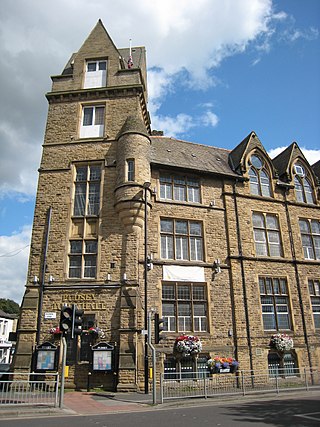
South Pembrokeshire was one of six local government districts of Dyfed, Wales from 1974 to 1996.

Narberth is a town and community in Pembrokeshire, Wales. It was founded around a Welsh court and later became a Norman stronghold on the Landsker Line. It became the headquarters of the hundred of Narberth. It was once a marcher borough. George Owen described it in 1603 as one of nine Pembrokeshire "boroughs in decay".

Yeadon Town Hall is a municipal building in Yeadon, West Yorkshire, England. It is Grade II listed.

The Whittlesey Museum is a local history museum in Market Street, Whittlesey, Cambridgeshire, England. It is based on the ground floor of Whittlesey Town Hall, which is a Grade II listed building.

William Owen (1791–1879) was a Welsh architect working in Haverfordwest in the late Georgian and early Victorian periods. He built up a considerable practice in Pembrokeshire and Carmathenshire. He was the county surveyor of Pembrokeshire, four times Mayor of Haverfordwest and High Sheriff of Pembrokeshire in 1859.

Pudsey Town Hall is a municipal building in Robin Lane, Pudsey, West Yorkshire, England. The town hall was the headquarters of Pudsey Urban District Council from 1912 to 1974.

Congleton Town Hall is a municipal building in the High Street, Congleton, Cheshire, England. The town hall, which is the meeting place of Congleton Town Council, is a grade II* listed building.

Carmarthen Guildhall is a municipal structure in Guildhall Square, Carmarthen, Wales. The guildhall, which was the headquarters of Carmarthen Borough Council, is a Grade I listed building.

Knottingley Town Hall is a municipal building in Weeland Road, Knottingley, West Yorkshire, England. The structure, which served as the headquarters of Knottingley Urban District Council, now operates as a community centre.

Milford Haven Town Hall is a municipal structure in Hamilton Terrace, Milford Haven, Pembrokeshire, Wales.

Tring Market House is a municipal building in the High Street, Tring, Hertfordshire, England. The structure, which is the meeting place of Tring Town Council, is a Grade II listed building.

Tetbury Market House, also known as Tetbury Town Hall, is a municipal building in the Market Place, Tetbury, Gloucestershire, England. The building, which was used both as a market house and as a town hall until the late 19th century, is a Grade I listed building.

Llandovery Town Hall is a municipal building in Market Street, Llandovery in Carmarthenshire, Wales. The structure, which is used as the local public library, is a Grade II listed building.

Llanidloes Town Hall is a municipal building in Great Oak Street, Llanidloes in Powys, Wales. The structure, which is the meeting place of Llanidloes Town Council as well as the home of the Llanidloes Museum and the Llanidloes Public Library, is a Grade II listed building.

County Hall, formerly Aberaeron Town Hall, is a municipal building in Market Street, Aberaeron, Ceredigion, Wales. The structure, which is now used as a public library, is a Grade II listed building.

Llangollen Town Hall, is a municipal building in Castle Street, Llangollen, Denbighshire, Wales. The structure, which is the meeting place of Llangollen Town Council, is a Grade II listed building.

Bala Town Hall, known in the late 19th century as the County Hall, is a municipal building in Bala, Gwynedd, Wales. The structure, which is now used as a restaurant, is a Grade II listed building.

Fishguard Town Hall is a municipal building in the Market Square, Fishguard, Pembrokeshire, Wales. The structure, which is the meeting place of Fishguard and Goodwick Town Council, is a Grade II listed building.

Pembroke Town Hall is a municipal building in Main Street, Pembroke, Pembrokeshire, Wales. The structure, which is the meeting place of Pembroke Town Council, is a Grade II listed building.
Narberth Rural District was a rural district in the administrative county of Pembrokeshire, Wales from 1894 to 1974, covering an area in the east of the county.




















